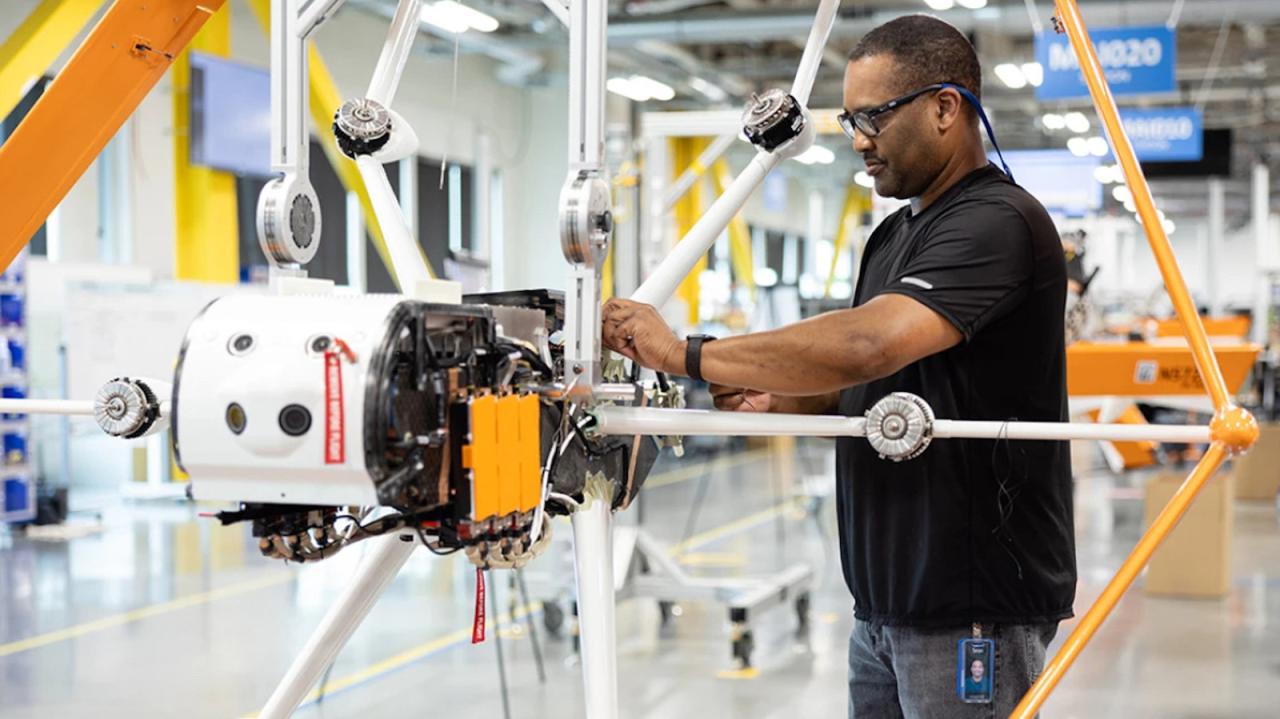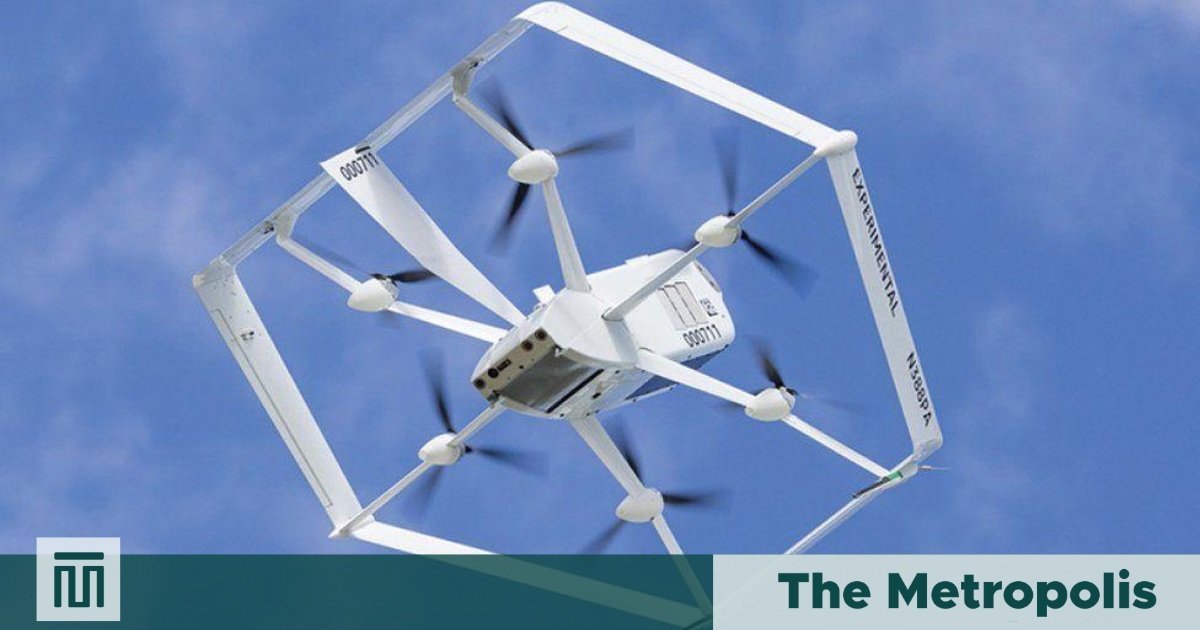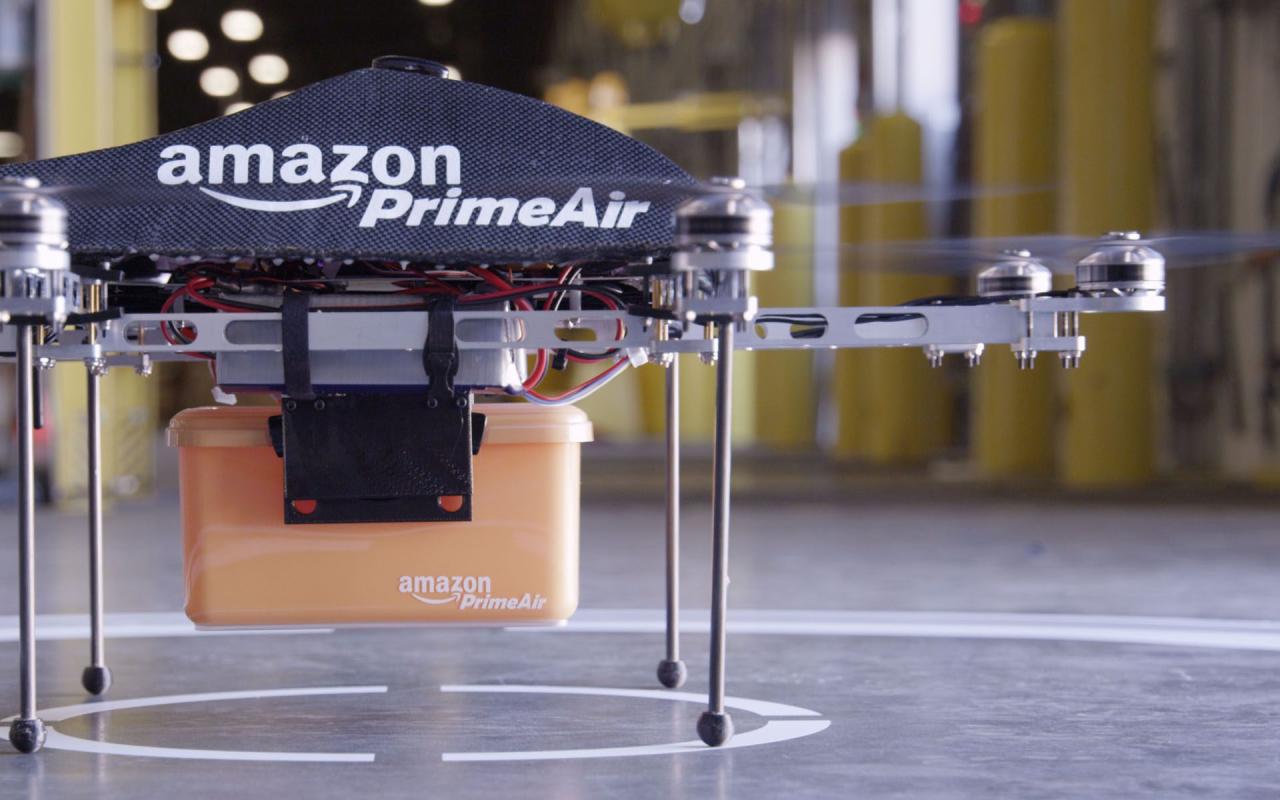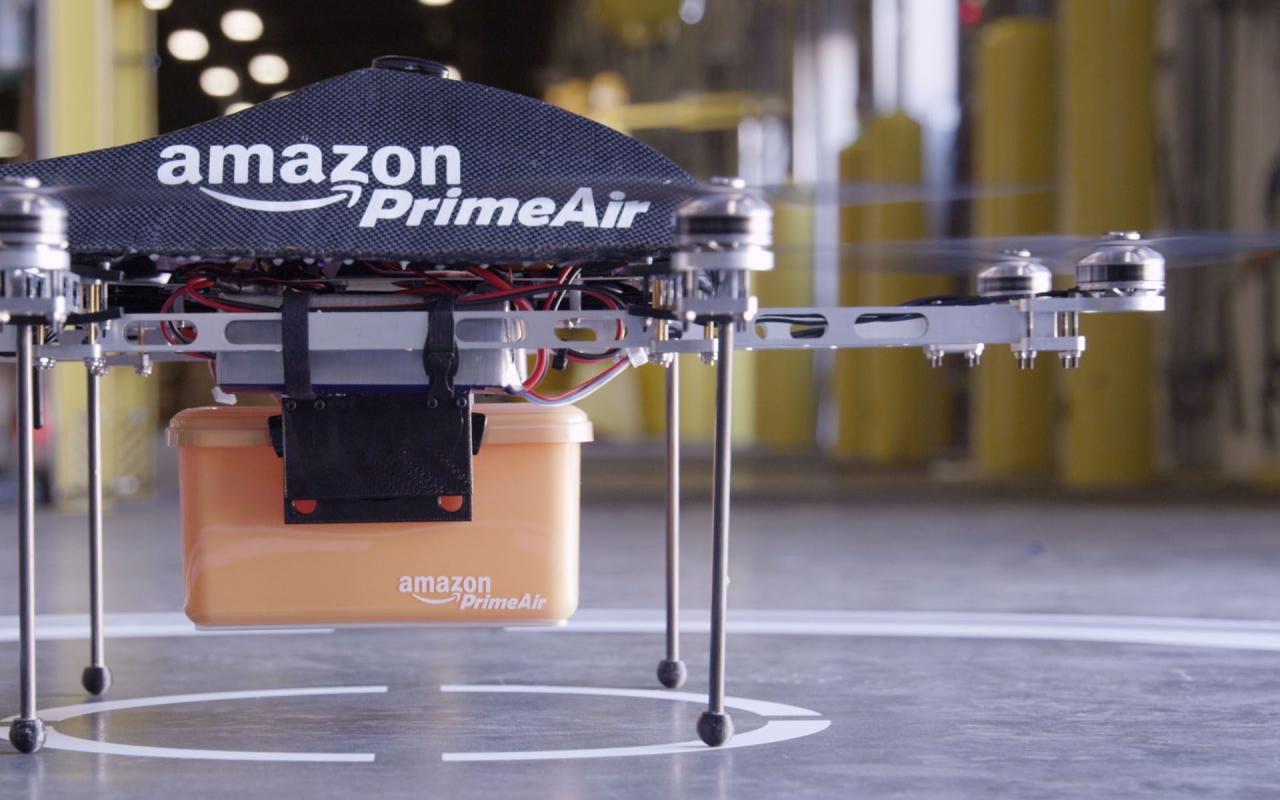Amazon drone delivery locations are rapidly expanding, revolutionizing how we receive packages. This guide explores the current state of Amazon’s drone delivery program, from its geographical reach and infrastructure requirements to safety regulations and environmental impact. We’ll delve into the customer experience, the technology behind it, and what the future holds for this innovative delivery method.
We’ll examine the infrastructure needed to support drone delivery, comparing urban and rural deployments and addressing challenges like weather conditions and navigating complex airspace. We’ll also discuss the safety protocols and regulations in place to ensure safe and efficient operations, while considering the environmental implications and exploring ways to minimize its footprint.
Current Amazon Drone Delivery Program Status
Amazon’s drone delivery program, known as Amazon Prime Air, is steadily expanding its reach, aiming to revolutionize the speed and efficiency of package delivery. While still in its relatively early stages, the program demonstrates significant progress towards a future where drones routinely transport smaller packages to customers’ doorsteps. This section details the current operational status, geographical reach, eligible products, and timeline of the program’s development.
Geographical Scope of Amazon Drone Delivery, Amazon drone delivery locations
Amazon Prime Air currently operates in a limited number of locations across the United States. The program’s expansion is gradual, focusing on areas with suitable infrastructure and regulatory approvals. Weather conditions significantly impact operations, with flights often suspended during inclement weather. Order size and weight restrictions also apply, limiting the program to smaller, lighter packages.
| State/Region | Active Program? | Limitations | Notes |
|---|---|---|---|
| California (select areas) | Yes | Weather dependent; limited package size and weight | Focus on rural and suburban communities. |
| Texas (select areas) | Yes | Weather dependent; limited package size and weight | Similar to California, targeting areas with less traffic congestion. |
| Kentucky (select areas) | Yes | Weather dependent; limited package size and weight | One of the initial test locations for the program. |
| Oregon (select areas) | Yes | Weather dependent; limited package size and weight | Expansion into a new region demonstrating ongoing growth. |
Eligible Products for Drone Delivery
Currently, Amazon Prime Air primarily delivers smaller, lightweight packages. These typically include everyday items such as books, electronics accessories, and certain household goods. Larger or heavier items, fragile goods, and those requiring special handling are not currently eligible for drone delivery. The selection of eligible products is continuously being evaluated and expanded as the program matures and technology improves.
The focus remains on items that can be safely and efficiently transported via drone within the existing weight and size constraints.
Timeline of Program Expansion
Amazon first announced its Prime Air drone delivery initiative in 2013. Early testing and development phases focused on perfecting the drone technology and navigating regulatory hurdles. Initial small-scale deliveries began in 2016, with a gradual expansion of the program’s geographical reach and eligible product categories in subsequent years. The program has faced several challenges, including regulatory approvals, technological advancements, and logistical considerations.
However, Amazon continues to invest heavily in Prime Air, demonstrating a long-term commitment to its development and eventual widespread deployment. The timeline reflects a deliberate, phased approach, prioritizing safety and efficiency over rapid expansion.
Infrastructure Requirements for Drone Delivery Locations

Setting up a successful drone delivery system requires careful planning and robust infrastructure. This includes not only the drones themselves but also the ground-based support systems necessary for safe, efficient, and reliable operations. Key elements are the designated landing zones, charging facilities, and communication networks that ensure constant connectivity and monitoring.
Hypothetical Infrastructure Map for a New Drone Delivery Location
A hypothetical drone delivery location would necessitate a well-defined infrastructure map. Imagine a small-scale operation serving a suburban neighborhood. The map would show several key features. First, designated landing zones would be marked, ideally on relatively flat, open areas like rooftops or designated patches of land within the delivery area. These zones would be clearly marked with visual indicators (e.g., brightly colored landing pads) and possibly GPS coordinates for precise drone navigation.
Second, a central hub would house the charging stations, maintenance facilities, and a control center. This hub would likely be located near the geographic center of the delivery area for optimal access. Finally, the map would also depict the communication network, which would consist of a robust network of strategically placed antennas or relay stations to ensure reliable communication between the drones and the control center, minimizing signal loss and maintaining constant connectivity across the delivery area.
This might include using cellular networks, dedicated Wi-Fi networks, or a combination of both, depending on the geographic characteristics of the delivery zone.
Infrastructure Needs: Urban vs. Rural Locations
Urban and rural drone delivery locations present distinctly different infrastructural challenges. Urban areas, with their dense populations and complex building structures, require smaller, more numerous landing zones, often located on rooftops or in designated urban spaces. Communication networks need to be highly reliable to penetrate the dense urban environment, possibly using a combination of technologies like 5G cellular networks and dedicated short-range communication systems to avoid signal blockage.
In contrast, rural areas often have more open space, allowing for larger, fewer landing zones. However, the distances between these zones and the central hub could be significantly greater, requiring drones with longer flight ranges and more robust communication systems with a wider coverage area, potentially utilizing technologies like long-range wireless communication or satellite links to ensure connectivity across vast distances.
Charging infrastructure might be more dispersed in rural areas to account for the increased travel times between landing zones and the central hub.
Challenges in Establishing Drone Delivery Infrastructure in Different Environments
Establishing drone delivery infrastructure faces unique challenges in various environments. Mountainous areas present significant obstacles due to unpredictable weather patterns, difficult terrain for drone navigation, and challenges in establishing reliable communication networks across varied elevations. Dense urban centers, as mentioned, present issues with finding suitable landing zones and maintaining consistent communication signals due to signal interference and building obstructions.
Areas with significant water bodies, like coastal regions or regions with numerous lakes and rivers, require consideration of drone safety and emergency protocols in case of unforeseen malfunctions. These environmental factors need to be thoroughly considered during the design and implementation phases to ensure safe and effective drone operations.
Amazon’s drone delivery program is expanding to new locations, aiming for faster and more efficient shipping. It’s interesting to compare this planned expansion with recent news, like the strange happenings detailed in this article about a mystery drone in Paris , which raises questions about unauthorized drone activity and airspace regulation. Ultimately, understanding these kinds of incidents is crucial for responsible drone development and the safe integration of drone delivery services like Amazon’s.
Safety and Regulatory Aspects of Drone Delivery Locations

Safe and efficient drone delivery requires careful consideration of various safety protocols and regulatory compliance. This section details the key aspects to ensure both public and operational safety. We’ll explore the regulations governing drone operations, the measures implemented to mitigate risks, and the potential hazards involved in drone deliveries.
Operating drones for commercial purposes, especially delivery, is subject to a complex web of regulations that vary significantly by location. These regulations aim to protect the public from potential hazards associated with drone operations, ensuring responsible and safe integration of drones into the airspace.
Key Safety Protocols and Regulations
Understanding and adhering to these regulations is paramount for successful and safe drone delivery operations. Failure to comply can result in significant penalties, including fines and operational suspensions.
- Registration and Licensing: Drone operators must register their drones and obtain the necessary licenses or permits from the relevant aviation authorities (e.g., the FAA in the US, EASA in Europe). This ensures accountability and allows for tracking of drone operations.
- Operational Limitations: Regulations often dictate operational limitations, such as maximum altitudes, operational distances from airports and populated areas, and visual line-of-sight requirements. These limits are designed to minimize the risk of collisions and accidents.
- Weather Restrictions: Drone operations are often restricted during adverse weather conditions, such as strong winds, heavy rain, or low visibility. Operating drones in such conditions poses significant safety risks.
- Emergency Procedures: Operators must have established emergency procedures in place to handle situations such as drone malfunctions, loss of control, or unexpected events. These procedures should include communication protocols and contingency plans.
- Data Privacy and Security: Regulations regarding data privacy and security are crucial, particularly given the potential for drones to collect sensitive information during delivery operations. Data encryption and secure storage practices are essential.
Measures to Ensure Safety During Delivery Operations
Beyond regulatory compliance, several proactive measures are crucial for ensuring the safety of both drones and people during delivery operations. These measures aim to mitigate potential risks and prevent accidents.
- Redundant Systems: Drones are often equipped with redundant systems, such as backup batteries and propulsion systems, to mitigate the risk of failure during flight. This redundancy ensures that the drone can safely land in case of a primary system malfunction.
- Obstacle Avoidance Technology: Advanced obstacle avoidance systems using sensors (e.g., lidar, radar, cameras) help drones navigate complex environments and avoid collisions with obstacles, such as buildings, trees, and power lines. This technology significantly enhances safety.
- Geo-fencing and Flight Planning Software: Geo-fencing technology restricts drone operation to pre-defined areas, preventing unauthorized flights and reducing the risk of entering restricted airspace. Flight planning software allows operators to pre-program flight paths, optimizing routes and minimizing potential hazards.
- Drone Tracking and Monitoring: Real-time tracking and monitoring systems allow operators to track the location and status of drones throughout their flights, providing immediate awareness of any potential issues. This allows for prompt intervention if necessary.
- Regular Maintenance and Inspections: Regular maintenance and inspections of drones are crucial to ensure their airworthiness and prevent malfunctions. This includes thorough checks of all components, including batteries, motors, and sensors.
Potential Risks and Mitigation Strategies
Despite safety measures, certain risks are inherent in drone delivery operations. Understanding these risks and implementing effective mitigation strategies is critical for safe and responsible operation.
- Drone Malfunctions: Mechanical failures, software glitches, or battery issues can lead to drone crashes or loss of control. Mitigation strategies include redundant systems, regular maintenance, and rigorous pre-flight checks.
- Collisions with Obstacles or Aircraft: Collisions with birds, other aircraft, or obstacles can cause serious damage or injury. Mitigation strategies include obstacle avoidance technology, weather monitoring, and adherence to airspace restrictions.
- Data Breaches and Privacy Violations: Data breaches can expose sensitive customer information or compromise the security of delivery operations. Mitigation strategies include robust data encryption, secure data storage, and compliance with data privacy regulations.
- Unauthorized Access and Tampering: Unauthorized access to drones or tampering with packages can lead to theft or damage. Mitigation strategies include secure locking mechanisms, GPS tracking, and tamper-evident packaging.
- Adverse Weather Conditions: Strong winds, rain, or snow can significantly impact drone performance and safety. Mitigation strategies include weather monitoring, flight cancellations during adverse conditions, and the use of weather-resistant drones.
Customer Experience and Logistics of Drone Delivery
Getting your package via Amazon drone is designed to be a smooth and convenient experience. From the moment you place your order to the time the drone delivers it to your doorstep, Amazon aims for a seamless process that minimizes hassle and maximizes efficiency. This section details the customer journey and the logistical intricacies behind this innovative delivery method.
The entire process is built around transparency and ease of use. Customers are kept informed every step of the way, from order confirmation to estimated delivery windows and real-time tracking. Amazon leverages its robust technology infrastructure to ensure a reliable and efficient drone delivery system, balancing speed with safety and accuracy.
The Customer Journey: From Order to Delivery
Here’s a step-by-step breakdown of what a customer can expect when ordering an item for drone delivery:
- Order Placement: The customer places an order through the Amazon app or website, selecting the drone delivery option where available.
- Order Confirmation and Tracking: The customer receives an order confirmation, including an estimated delivery window. Real-time tracking information is then provided via the app, showing the drone’s location and estimated time of arrival.
- Delivery Notification: The customer receives a notification when the drone is approaching their delivery location. This might include a visual or auditory cue, depending on the drone’s capabilities and the customer’s preferences.
- Drone Arrival and Package Drop-off: The drone autonomously lands in a designated safe zone (e.g., customer’s backyard) and releases the package using a secure mechanism. The customer can then retrieve the package.
- Delivery Confirmation: The app updates to confirm successful delivery, and the customer can leave feedback on their experience.
Amazon’s Order Fulfillment and Routing
Efficiently managing drone deliveries requires sophisticated logistics. Amazon utilizes a complex system to optimize order fulfillment and routing, taking several key factors into account:
Amazon’s fulfillment centers strategically located near drone delivery hubs play a crucial role. Orders slated for drone delivery are processed and packaged at these facilities. Advanced algorithms then determine the optimal flight path for each drone, considering factors like distance, weather conditions, air traffic, and battery life. Real-time monitoring and adjustments ensure drones reach their destinations efficiently and safely.
For example, if unexpected weather delays a flight, the system will automatically adjust the delivery window and communicate this change to the customer. Amazon also incorporates redundancy in its system, with multiple drones and delivery routes planned to mitigate potential disruptions. This ensures that even if one drone encounters a problem, the delivery can still be completed efficiently.
Environmental Impact of Amazon Drone Delivery: Amazon Drone Delivery Locations
Amazon’s drone delivery program, while offering speed and convenience, presents a complex environmental picture. We need to carefully consider the trade-offs between efficiency gains and potential ecological consequences to ensure responsible development and implementation. This involves examining fuel consumption, noise pollution, and waste generation, comparing them to traditional delivery methods, and exploring strategies for minimizing the overall environmental footprint.
Fuel Consumption in Drone Delivery
The environmental impact of drone delivery is significantly tied to the energy source powering the drones. Currently, most delivery drones utilize battery power, which relies on electricity generation. The environmental impact of this electricity depends heavily on the source: renewable sources like solar and wind power minimize the carbon footprint, while reliance on fossil fuels significantly increases it. The energy required to manufacture and dispose of the batteries also contributes to the overall environmental impact.
A crucial factor is the drone’s efficiency – a more energy-efficient drone design can substantially reduce fuel consumption and emissions per delivery. For example, advancements in battery technology and aerodynamic design could lead to significant reductions in energy needs. Furthermore, the charging infrastructure itself needs to be considered, as it could increase energy demand if not powered sustainably.
Noise Pollution from Drone Operations
Drone noise is a significant concern, particularly in residential areas. The whirring of rotors can be disruptive to local wildlife and human populations, impacting both quality of life and potentially causing stress-related health issues. The intensity and frequency of the noise depend on the drone’s design, size, and the number of flights. Unlike traditional delivery trucks that often follow established routes, drones can fly over a wider area, potentially exposing more people to noise pollution.
So you’re curious about Amazon drone delivery locations? They’re expanding rapidly, but safety is key. Think about the recent mishap; check out this report on the orlando drone show accident to see why careful planning and regulation are crucial for widespread drone use. This incident highlights the importance of robust safety protocols as Amazon continues to develop its drone delivery network.
Strategies to mitigate this include optimizing flight paths to avoid densely populated areas and using quieter drone designs, perhaps employing different rotor configurations or noise-dampening materials. Comparative studies assessing noise levels from drones versus traditional delivery vehicles in various urban environments would provide valuable data for informing policy and technological advancements.
Waste Generation Associated with Drone Deliveries
While drones themselves can be reused and recycled, the packaging associated with drone deliveries contributes to waste generation. Designing lightweight, recyclable, and biodegradable packaging is crucial for minimizing the environmental impact. This involves moving away from excessive plastic packaging and exploring options such as compostable materials or reusable containers. Furthermore, the potential for lost or damaged packages during drone delivery could lead to increased waste if replacement shipments are necessary.
Efficient logistics and robust drone design that minimizes the risk of package damage are essential in this regard. A comparison of the packaging waste generated by drone deliveries versus traditional delivery methods would highlight the need for sustainable packaging solutions in the drone delivery sector.
Comparison with Traditional Delivery Methods
Comparing drone delivery to traditional methods reveals a complex picture. While drones might reduce fuel consumption per package in some scenarios, especially for shorter distances, the overall environmental impact depends on factors like the energy source for charging, packaging waste, and noise pollution. Traditional delivery trucks, while having larger individual carbon footprints, often operate on established routes, leading to higher efficiency for large-scale deliveries.
The manufacturing and maintenance of drones also introduce an additional environmental factor that needs to be factored into a comprehensive life-cycle assessment. For instance, a study comparing the carbon footprint of a single drone delivery with that of a traditional delivery truck carrying multiple packages within a specific geographical area would offer valuable insights.
Strategies for Minimizing Environmental Impact
Several strategies can minimize the environmental impact of drone delivery. These include transitioning to renewable energy sources for charging drones, optimizing flight paths to reduce both energy consumption and noise pollution, designing quieter drones, and promoting the use of sustainable packaging materials. Investment in research and development of more energy-efficient drone designs, including improved battery technology and aerodynamics, is critical.
Furthermore, integrating drone delivery into a broader sustainable logistics strategy, such as optimizing delivery routes to minimize the overall number of flights and integrating with other eco-friendly transportation modes, would contribute significantly to reducing the environmental footprint. Incentivizing the use of sustainable packaging and implementing effective waste management systems for drone-related waste are equally crucial.
Future of Amazon Drone Delivery Locations
Amazon’s drone delivery program, while still in its relatively early stages, shows immense potential for future expansion and technological integration. Its success hinges on overcoming current limitations and adapting to evolving technologies and regulatory landscapes. We can expect significant changes in the coming years, impacting both the geographical reach and the operational capabilities of the service.The future of Amazon drone delivery locations will likely involve a significant expansion of its operational area.
Currently, the program operates in select regions; however, we can anticipate a gradual increase in the number of delivery locations across the United States and, eventually, globally. This expansion will be driven by technological advancements, regulatory approvals, and increasing consumer demand for faster and more convenient delivery options. For example, we might see a scenario where densely populated urban areas, initially challenging due to airspace restrictions, become viable delivery zones thanks to advanced drone traffic management systems.
Similarly, rural areas currently underserved by traditional delivery methods could see a significant improvement in access to goods and services via drone delivery.
Geographical Expansion and Service Capabilities
Amazon’s expansion will likely follow a phased approach, prioritizing areas with suitable infrastructure and favorable regulatory environments. We might see a concentration of delivery hubs in suburban and less densely populated areas initially, gradually expanding into more challenging urban environments as technology matures. The service capabilities themselves will also evolve. Initially focused on smaller, lighter packages, drone delivery could eventually handle a wider range of goods, potentially including heavier items or those requiring temperature control, through advancements in drone technology and battery life.
So you’re curious about where Amazon’s delivering packages via drone, huh? It’s pretty cool tech! To get a clearer picture of the current operational areas, check out this helpful resource on amazon drone delivery locations. Knowing these locations helps you understand the scope and future potential of this delivery method. Amazon drone delivery locations are expanding, so keep an eye out for updates!
We can envision a future where drone delivery is not just a supplementary service but a primary mode of delivery for many Amazon products, offering same-day or even same-hour delivery in select areas. This expansion would require significant investment in infrastructure, including more delivery hubs and charging stations, as well as ongoing technological improvements in the drones themselves.
Technological Advancements Impacting Drone Delivery
Several technological advancements will be crucial to the future of Amazon drone delivery. Improvements in battery technology, for example, are paramount. Longer flight times will allow drones to cover greater distances and deliver to more remote locations. Autonomous navigation systems are also key. More sophisticated AI-powered navigation will allow for safer and more efficient flight paths, especially in complex urban environments.
The development of drone traffic management systems (DTMS) is essential to prevent collisions and ensure safe and efficient airspace management. Imagine a future where drones can seamlessly navigate around obstacles and other air traffic, thanks to advanced sensor technology and AI-based decision-making. Furthermore, advancements in package handling mechanisms will allow drones to handle a greater variety of package sizes and weights, expanding the range of products that can be delivered via drone.
Integration with Other Amazon Logistics Services
The future likely involves a seamless integration of drone delivery with other Amazon logistics services. For instance, drones could act as a “last-mile” delivery solution, taking packages from a larger delivery vehicle or distribution center to the final customer’s doorstep. This would optimize delivery routes and reduce overall delivery times. We might also see drones working in conjunction with Amazon’s existing delivery network, such as its fleet of delivery vans or its network of fulfillment centers, to create a more efficient and comprehensive logistics system.
This integration could lead to a more cost-effective and environmentally friendly delivery system, as drones could be used for shorter, more efficient delivery routes, reducing the overall fuel consumption and carbon footprint of the entire delivery process. This synergy would not only enhance delivery speed and efficiency but also contribute to a more sustainable logistics network.
Final Thoughts

Amazon’s drone delivery program represents a significant shift in logistics, offering faster and potentially more sustainable delivery options. While challenges remain in terms of infrastructure, regulation, and environmental impact, the ongoing development and expansion of this technology promise a future where quick, efficient, and environmentally conscious package delivery becomes the norm. As the program continues to evolve, we can expect to see further expansion into new areas and improvements in technology, leading to a more seamless and efficient delivery experience for consumers.
FAQ Explained
What types of packages can be delivered by Amazon drones?
Currently, Amazon drones deliver smaller packages weighing under a certain limit. The exact weight and size restrictions vary depending on the location and operational conditions.
How do I know if drone delivery is available in my area?
Check the Amazon website or app during checkout. If drone delivery is an option in your area, it will be displayed as a delivery method.
What happens if there’s bad weather?
Drone deliveries are weather-dependent. In inclement weather, the delivery may be delayed or switched to a traditional delivery method.
Is drone delivery more expensive than traditional delivery?
Currently, there’s usually no additional charge for drone delivery, but this may change in the future.
